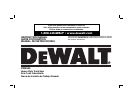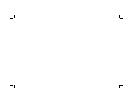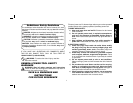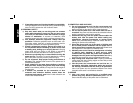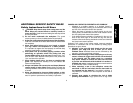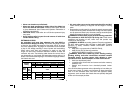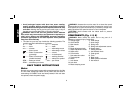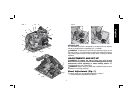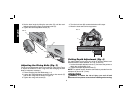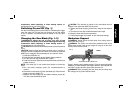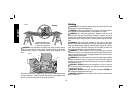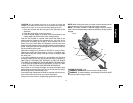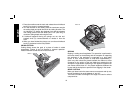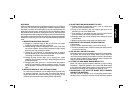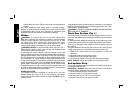
English
4
their own weight. Support must be placed under the panel
on both sides, near the line of cut and near the edge of the
panel.
e) Do not use dull or damaged blade. Unsharpened or
improperly set blades produce narrow kerf causing excessive
friction, blade binding, and kickback.
f) Blade depth and bevel adjusting locking levers must be
tight and secure before making cut. If blade adjustment
shifts while cutting, it may cause binding and kickback.
g) Use extra caution when making a “Plunge Cut” into
existing walls or other blind areas. The protruding blade
may cut objects that can cause kickback.
Safety Instructions for Plunge-Type
Saws
a) Check guard for proper closing before each use. Do
not operate the saw if guard does not move freely and
enclose the blade instantly. Never clamp or tie the guard
with the blade exposed. If saw is accidentally dropped,
guard may be bent. Check to make sure that guard moves
freely and does not touch the blade or any other part, in all
angles and depths of cut.
b) Check the operation and condition of the guard return
spring. If the guard and the spring are not operating
properly, they must be serviced before use. Guard may
operate sluggishly due to damaged parts, gummy deposits,
or a build-up of debris.
c) Assure that the guide plate of the saw will not shift while
performing the “plunge cut” when the blade bevel setting
is not at 90°. Blade shifting sideways will cause binding and
likely kickback.
d) Always observe that the guard is covering the blade before
placing saw down on bench or floor. An unprotected,
coasting blade will cause the saw to walk backwards, cutting
whatever is in its path. Be aware of the time it takes for the
blade to stop after switch is released.
Additional Safety Instructions for All
Saws with Riving Knife
a) Use the appropriate riving knife for the blade being used.
For the riving knife to work, it must be thicker than the body
of the blade but thinner than the tooth set of the blade.
b) Adjust the riving knife as described in this instruction
manual. Incorrect spacing, positioning and alignment can
make the riving knife ineffective in preventing kickback.
c) Always use the riving knife except when plunge cutting.
Riving knife must be replaced after plunge cutting. Riving
knife causes interference during plunge cutting and can
create kickback. Model DWS520 does not require removal
of the riving knife because the riving knife retracts during a
plunge cut.
d) For the riving knife to work, it must be engaged in the
workpiece. The riving knife is ineffective in preventing
kickback during short cuts.
e) Do not operate the saw if riving knife is bent. Even a light
interference can slow the closing rate of a guard.
Additional Safety Instructions for Saws
• Wear ear protectors. Exposure to noise can cause hearing
loss.
• Wear a dust mask. Exposure to dust particles can cause
breathing difficulty and possible injury.
• Use only recommended blades. The saw is designed for use
with 6-1/2" (165 mm) diameter blades that have a 0.79" (20 mm)
diameter bore. Blades must be rated for 6000 RPM operation (or
higher).



